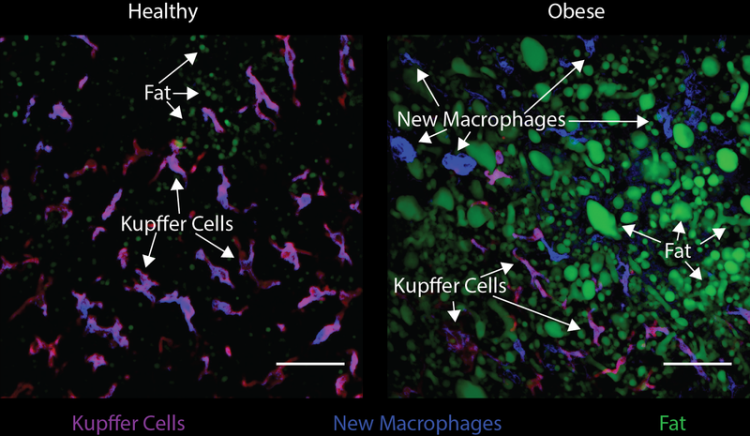Obesity affects the immune cells in the liver
By investigating the livers of obese mice, the team of Prof. Charlotte Scott (VIB-UGent Center for Inflammation Research) has identified a new population of macrophages (immune cells) not present in healthy livers. These new cells were primarily located in the most damaged regions of the obese liver where they produce a protein that can be used to identify patients with severe fatty liver disease. With no treatment currently available for fatty liver disease, this discovery opens up potential new treatment options aimed at specifically targeting the different macrophages to improve patient outcomes.
Immune cells and fatty liver
Metabolic associated fatty liver disease (MAFLD) represents a spectrum of disease states ranging from a build-up of fat in the liver to the more severe stages of the disease leading to fibrosis, cirrhosis and in some cases liver cancer. To date there is no treatment available for patients with the more advanced stages of this disease.
Typically, the only option is liver transplantation. Recent work suggested that macrophages (immune cells) in the liver may play an important role in the development of this disease. This led the team of Prof. Scott to investigate the involvement of macrophages in this disease.
The team fed mice a western diet rich in fat, cholesterol and sugar, or a standard, balanced diet as a control. The researchers then used the latest single-cell technologies to investigate the immune cells present on a cell by cell basis.
“Our analysis uncovered a new population of macrophages present in the diseased livers but absent from the healthy livers” says Anneleen Remmerie, the PhD student leading the work. “Then, we focused on investigating the differences between the macrophage populations and the relevance for the disease”.
A new type of macrophage
Metabolic associated fatty liver disease (MAFLD) represents a spectrum of disease states ranging from a build-up of fat in the liver to the more severe stages of the disease leading to fibrosis, cirrhosis and in some cases liver cancer. To date there is no treatment available for patients with the more advanced stages of this disease. Typically, the only option is liver transplantation. Recent work suggested that macrophages (immune cells) in the liver may play an important role in the development of this disease. This led the team of Prof. Scott to investigate the involvement of macrophages in this disease.
The team fed mice a western diet rich in fat, cholesterol and sugar, or a standard, balanced diet as a control. The researchers then used the latest single-cell technologies to investigate the immune cells present on a cell by cell basis.
“Our analysis uncovered a new population of macrophages present in the diseased livers but absent from the healthy livers” says Anneleen Remmerie, the PhD student leading the work. “Then, we focused on investigating the differences between the macrophage populations and the relevance for the disease”.

